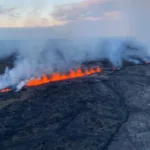Hawaii, the volcanic hotspot of the Pacific, has been at the center of global attention in 2024 due to its remarkable volcanic activity. Among its majestic peaks, Kīlauea volcano has once again demonstrated its fiery power, cementing its place as one of the world’s most active volcanoes. This article delves into the eruptions in Hawaii during 2024, focusing on Kīlauea, its impact, and the fascinating science behind these geological phenomena.
Introduction to Hawaii’s Volcanic Legacy
Hawaii is synonymous with volcanoes. These islands owe their very existence to millions of years of volcanic activity, with their fiery origins traced to a hotspot beneath the Pacific Plate. Today, volcanoes like Kīlauea and Mauna Loa remain active, shaping Hawaii’s landscapes and drawing millions of curious visitors.
In 2024, Kīlauea took center stage again with multiple eruptions, offering a mix of awe and scientific intrigue. But why is Kīlauea so active, and how have these recent eruptions unfolded?
A Year of Activity: The 2024 Kīlauea Eruptions
1. Overview of Kīlauea Volcano
Kīlauea, located on the Big Island, is one of the most active volcanoes globally. Known for its consistent activity over decades, this shield volcano typically produces effusive eruptions, characterized by flowing lava rather than explosive bursts.
In 2024, Kīlauea experienced several eruptions that captivated geologists, residents, and tourists alike.
2. The January Eruption
The year began with a bang when Kīlauea erupted in early January 2024. Lava fountains illuminated the night sky, and the activity was concentrated within the Halemaʻumaʻu crater at the summit. This eruption was relatively short-lived, lasting just a week, but it set the tone for what was to come.
Key Highlights
- Location: Halemaʻumaʻu crater.
- Duration: 7 days.
- Impact: Minimal threats to populated areas, but significant vog (volcanic smog) affected air quality.
3. The June Event
One of the most dramatic eruptions occurred in June. Lava flows extended from Kīlauea’s rift zones, showcasing the volcano’s relentless energy. While the eruption was confined to uninhabited areas, it served as a reminder of the island’s volatile nature.
Environmental and Human Impact
- Air Quality: Elevated levels of sulfur dioxide led to vog, affecting sensitive groups.
- Tourism: The eruption attracted visitors eager to witness lava flows in real-time, boosting local tourism.
4. September’s Surprise
September brought an unexpected eruption in Kīlauea’s middle east rift zone, near the remote Nāpau Crater. This multi-phase eruption, lasting over a week, provided critical data for scientists studying magma movement beneath the surface.
5. The December Finale
As if saving the most spectacular for last, Kīlauea erupted again on December 23, 2024. This eruption was characterized by stunning lava fountains visible for miles. Happening during the holiday season, it attracted thousands of visitors to Hawaii Volcanoes National Park.
Understanding the Science Behind Kīlauea’s Activity
1. Why Does Kīlauea Erupt So Frequently?
Hawaii sits over a stationary volcanic hotspot, where magma from deep within the Earth rises to the surface. Kīlauea’s position at the southeastern end of the Hawaiian chain makes it the current focal point of this activity.
2. What Triggers an Eruption?
Eruptions are driven by pressure buildup in underground magma chambers. When this pressure exceeds the strength of the overlying rock, magma escapes through cracks, resulting in an eruption.
Impacts of the 2024 Eruptions
1. Environmental Effects
- Lava Flows: Lava reshaped parts of Kīlauea’s summit and rift zones, adding new layers to the Big Island’s surface.
- Air Quality: Volcanic gases, particularly sulfur dioxide, created vog, impacting visibility and respiratory health.
2. Economic Impacts
- Tourism saw a surge, with visitors flocking to witness the eruptions.
- Local businesses near the park benefited from increased foot traffic.
Tips for Visitors to Hawaii During Volcanic Activity
1. Plan Your Trip
If you’re planning to visit Hawaii during an eruption, timing and preparation are key. Check updates from the US Geological Survey (USGS) for the latest volcanic activity reports.
2. Safety First
- Stay within designated viewing areas.
- Wear masks if vog levels are high.
- Avoid venturing into closed zones.
FAQs About Hawaii’s 2024 Volcanic Activity
1. Was Mauna Loa Active in 2024?
While Mauna Loa, another massive volcano on the Big Island, remained dormant, it continues to be closely monitored.
2. Were Any Communities Evacuated?
Thanks to Hawaii’s advanced monitoring systems, residents were not directly threatened during Kīlauea’s 2024 eruptions. The eruptions were confined to unpopulated areas.
3. Can Tourists Safely View Eruptions?
Yes, Hawaii Volcanoes National Park offers safe viewing areas. Always follow guidelines provided by park authorities.
4. What Causes Vog?
Vog forms when sulfur dioxide from eruptions reacts with sunlight, oxygen, and moisture. It can cause respiratory issues, especially for sensitive groups.
5. How Can I Learn More About Kīlauea?
Visit the USGS Volcanoes website for detailed updates and educational resources.
Conclusion
Kīlauea’s eruptions in 2024 remind us of nature’s raw power and beauty. While these events posed some challenges, they also provided valuable scientific insights and an unforgettable spectacle for those lucky enough to witness them.
Hawaii’s volcanoes are a testament to the Earth’s dynamic processes. Whether you’re a scientist, a traveler, or simply a nature enthusiast, Kīlauea’s fiery displays are a reminder of our planet’s ever-changing nature.
What are your thoughts on Kīlauea’s 2024 eruptions? Let us know in the comments below. If you’ve ever visited Hawaii during a volcanic event, share your experience!






